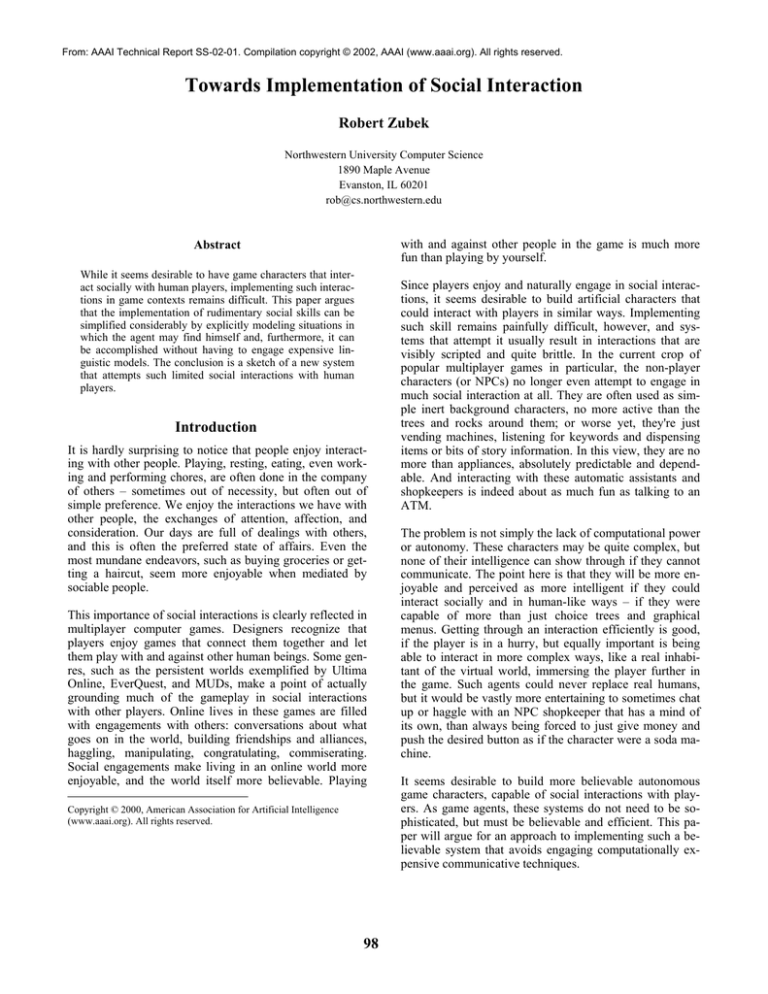
From: AAAI Technical Report SS-02-01. Compilation copyright © 2002, AAAI (www.aaai.org). All rights reserved.
Towards Implementation of Social Interaction
Robert Zubek
Northwestern University Computer Science
1890 Maple Avenue
Evanston, IL 60201
rob@cs.northwestern.edu
with and against other people in the game is much more
fun than playing by yourself.
Abstract
While it seems desirable to have game characters that interact socially with human players, implementing such interactions in game contexts remains difficult. This paper argues
that the implementation of rudimentary social skills can be
simplified considerably by explicitly modeling situations in
which the agent may find himself and, furthermore, it can
be accomplished without having to engage expensive linguistic models. The conclusion is a sketch of a new system
that attempts such limited social interactions with human
players.
Introduction
It is hardly surprising to notice that people enjoy interacting with other people. Playing, resting, eating, even working and performing chores, are often done in the company
of others – sometimes out of necessity, but often out of
simple preference. We enjoy the interactions we have with
other people, the exchanges of attention, affection, and
consideration. Our days are full of dealings with others,
and this is often the preferred state of affairs. Even the
most mundane endeavors, such as buying groceries or getting a haircut, seem more enjoyable when mediated by
sociable people.
This importance of social interactions is clearly reflected in
multiplayer computer games. Designers recognize that
players enjoy games that connect them together and let
them play with and against other human beings. Some genres, such as the persistent worlds exemplified by Ultima
Online, EverQuest, and MUDs, make a point of actually
grounding much of the gameplay in social interactions
with other players. Online lives in these games are filled
with engagements with others: conversations about what
goes on in the world, building friendships and alliances,
haggling, manipulating, congratulating, commiserating.
Social engagements make living in an online world more
enjoyable, and the world itself more believable. Playing
Copyright © 2000, American Association for Artificial Intelligence
(www.aaai.org). All rights reserved.
98
Since players enjoy and naturally engage in social interactions, it seems desirable to build artificial characters that
could interact with players in similar ways. Implementing
such skill remains painfully difficult, however, and systems that attempt it usually result in interactions that are
visibly scripted and quite brittle. In the current crop of
popular multiplayer games in particular, the non-player
characters (or NPCs) no longer even attempt to engage in
much social interaction at all. They are often used as simple inert background characters, no more active than the
trees and rocks around them; or worse yet, they're just
vending machines, listening for keywords and dispensing
items or bits of story information. In this view, they are no
more than appliances, absolutely predictable and dependable. And interacting with these automatic assistants and
shopkeepers is indeed about as much fun as talking to an
ATM.
The problem is not simply the lack of computational power
or autonomy. These characters may be quite complex, but
none of their intelligence can show through if they cannot
communicate. The point here is that they will be more enjoyable and perceived as more intelligent if they could
interact socially and in human-like ways – if they were
capable of more than just choice trees and graphical
menus. Getting through an interaction efficiently is good,
if the player is in a hurry, but equally important is being
able to interact in more complex ways, like a real inhabitant of the virtual world, immersing the player further in
the game. Such agents could never replace real humans,
but it would be vastly more entertaining to sometimes chat
up or haggle with an NPC shopkeeper that has a mind of
its own, than always being forced to just give money and
push the desired button as if the character were a soda machine.
It seems desirable to build more believable autonomous
game characters, capable of social interactions with players. As game agents, these systems do not need to be sophisticated, but must be believable and efficient. This paper will argue for an approach to implementing such a believable system that avoids engaging computationally expensive communicative techniques.
Social interaction
As we consider the problem of designing believable, socially interactive characters, we must consider the layers of
communication and meaning that constitute even the most
common interactions. Their complexity is overwhelming
and implementation may seem impossible, as the computer
doesn’t really understand our ways and our languages.
Indeed, in the general case, this is an extraordinarily difficult, “AI-complete” problem.
We can make the problem simpler by allowing ourselves
to limit the scope of interaction. Certainly, we cannot build
human-level AI – but we can build specialized characters,
whose social interactions in specific domains are much
more believable. The domains examined in this work will
be the mundane interactions that fill the days in computer
worlds. These are common enough to be worth examining,
and their routine structure will also simplify implementation.
For an example that might put the remainder of this discussion in context, imagine how a traveler might cope in a
foreign country, full of people he doesn’t understand. He
would likely have a basic grasp of how the society works,
but not know much language – maybe some of the most
useful words, maybe even less.1 And yet, even without
knowledge of the local language, the traveler can nevertheless be quite successful in interacting with others. Even
with meager language skills, he will be able to get by: obtain food and the essentials, get from place to place, perhaps even perform some basic jobs. Certainly, he could not
participate in all that the society has to offer, but neither
will he be completely lost. He will be able to get through
interactions with other people, and survive in their society,
even though he does not speak their language.
None of this should be surprising – as mature individuals,
we can maneuver our way through typical social interactions even without knowing the language, so long as we
know how to behave in each situation. We know what is
involved in buying groceries, getting on a bus, and other
common interactions. These stereotyped situations only
require us to get a general grasp of the interaction, coordinate with others on just the few missing bits of information, and generally behave in the way one generally behaves in these situations. And even though each interaction
will be different, we all have ways of monitoring and handling its flow, detecting potential problems, and repairing
it when it breaks.
1
The inverse is also interesting – when a traveler understands the language, but not the society. This leads to much more subtle problems that
can be quite embarrassing for the participants, rather fun for the onlookers, but unfortunately completely outside the scope of this paper.
99
Equipped with the knowledge of stereotyped interactions,
and knowledge of how to maintain and repair an ongoing
interaction, the traveler is thus prepared to cope in a foreign society. When faced with a need to communicate, he
will try his best to navigate the situation he is in, and come
to an understanding with his conversational partner. Expectably, the conversation will never be smooth. The traveler will often make mistakes, find himself at a loss for
words, or need to convey what he means using gestures
and facial expressions. When he fails to understand what
had been said to him, he might have to simply try and
guess, from the emotional tone and body language, what
the other may be trying to communicate given the interactions thus far. But he will try to understand, try to communicate, and above all, try to reach some end-goal of interaction.
These mundane stereotyped interactions are exactly the
kind of a resource people use when faced with the need to
participate in a society whose language they do not understand. We can also use them as a starting point in implementation of social participation in a computer – considering them as a base mechanism of social interaction.
Stereotyped social interaction
Let us examine in greater detail what we mean by mundane, stereotyped social interactions.
In the process of socialization, human beings appear to
acquire a large repertoire of constructs for referring to routine social activities. They can be regarded as representations of typical actions performed by typical actors under
typical circumstances (Heritage, 1984, pp. 57-58), and they
let us get through everyday routines without paying attention to them. For example, our knowledge about how to
make purchases in a store, take public transportation, or
navigate through an intersection, are exactly those kinds of
typified constructs – all participants have an idea of the
information the interaction requires, a standard progression
of steps to get through, and we know how to go about getting through them. Thanks to such stereotyped constructs,
we do not need to analyze the situation to come up with the
right set of actions to perform. Rather, we know very well
the standard way of, say, going about making a purchase –
give the items to the cashier, who will tell you the total
price, give them the money, and so on. The routine works
so well that it disappears from our attention – indeed, we
do not notice it until it breaks.
Furthermore, the nature of these stereotyped routines is
that they are ‘anonymous’, in that they do not make reference to the participants’ individual feelings, goals, intentions, or even a more general organizational rationale for
their actions. Indeed, if the interaction is simple and not
collaborative or combative (that is, one is not deliberately
trying to help or harm the other), there is no need to assess
the individual characteristics of the participants. Thanks to
this anonymity, a large number of very different individu-
als with very different goals and abilities can effectively
interact with each other in a number of diverse routines.
The pervasiveness of such stereotyped interactions is fortunate and quite useful. This view of stereotyped interactions also suggests a possible finite-state implementation –
but before we discuss this in greater detail, let us briefly
examine the issues of participating in such an interaction.
Interaction as grounding for communication
Getting through a social interaction seems to require communication, and the common mode of communication is,
expectably, conversation. This suggests that in order to
engage in social interactions, we need to have at least rudimentary conversational skills, including some language
understanding.
Approaching language processing from a general linguistic
perspective, however, would immediately lead us to extraordinarily difficult problems. Conversational language is
full of contingencies that complicate traditional, decontextualized approaches to understanding. Syntax can certainly
be contingent on the context – utterances in a conversation
are notoriously ungrammatical, often missing important
elements, repeating them, mangling their order, and so on.
Similar contingencies are present on the semantic level –
utterances are full of ambiguities that require the history of
interaction to resolve, or expressions such as indexicals
that require a grounding in the situation in order to have
any discernible meaning at all. Finally, on the pragmatic
level, expressions rarely mean simply what they mean – to
really grasp the import of an expression we need to understand its place in the interaction at hand. And yet, bad
grammar and vague meanings usually pass unnoticed by
participants. Only when we read transcripts of casual conversations do we begin to realize how hopelessly messy
spoken language really is.
These problems are characteristic of everyday speech, and
very difficult to approach computationally. We will inevitably run into them, should we attempt understanding of
informal communication based only on the text of each
utterance. As Garfinkel eloquently demonstrates in many
of his essays (1967), human speakers tend to communicate
very little explicitly, instead relying on the mutual understanding of the evolving situation to provide the import of
their words. In a very concrete sense, the situation grounds
much of informal communication. This is also the kind of
communication that accomplishes mundane interactions.
We expect that these interactions, because they are so predictable, will provide a good grounding for communicative
understanding. The situation at hand can be used to set up
communicative expectations – we know more or less what
to expect at each point in a stereotyped interaction – and
these expectations will help us interpret the other person’s
utterances. For example, when walking into a bakery, we
place ourselves in the context of buying what is sold there,
100
and our attempts to communicate will be interpreted in that
light by others. Thus we do not need to order using full
declarative sentences such as “I would like a poppy seed
bagel, please.” By the virtue of the situation, all one needs
to say is “poppy seed bagel, please,” or perhaps just
“poppy bagel,” or even just grunt while pointing at the
desired item. Issues of politeness aside, this would have
communicated enough for the interaction to proceed to the
next stage. This reliance on context is especially useful if
we do not fully understand the language, in which case we
will succeed by force-fitting what we do understand into
what we expect to hear, and respond according to how well
we think we understand what is going on.
The point here is that the participants only need to understand each other well enough to get through the interaction. This will be made simpler by the situation, as there is
always an interpretation bias at play: once a typical interaction is engaged, participants are strongly biased to interpret
the communicative attempts of the other as relevant to advancing the interaction. Stereotyped situations will provide
better grounding than other contexts, because of their predictability.
Implementation outline
As we have seen, this project approaches the problem of
participation in social interactions by restricting it in two
ways:
1. Focus on mundane, stereotyped social interactions.
2. Perform understanding of language-in-context only.
This limited form of social interaction – using contextsensitive communication in well-defined contexts – is
vastly simpler to engage in than general social interaction.
Even humans make use of its simplicity, when they lack
sophisticated linguistic abilities. It does not mean, however, that these stereotyped interaction are all that there is
to interacting socially with others. Quite to the contrary,
they are only the beginning; we will treat them as a base
competence level, on which we could build more sophisticated characters.
The working hypothesis is that we could actually implement participation in these stereotyped interactions by explicitly modeling their progression. We can think of a single stereotyped situation as a set of state spaces, representing the anonymous roles that participants take on, the standard progression of events, and the information that needs
to be exchanged in order for the interaction to progress.
The complete system will include state models of many
such interactions, often stacking them in layers of competence; layers of models from very general to highly specialized. They all represent some partial understanding of
what goes on at the moment, all try to process what they
observe unfolding around them, and all recommend what
to do to further advance them.
Explicating the communicative expectations hiding in each
interaction will in turn help us communicate with the
player. Our movement through the interaction state space
will tell us what information we expect to be presented at
each point to advance the interaction, and the state of the
interaction will in turn tell us what we need to communicate to our interlocutor. In this manner, communication
only serves to drive the interaction through expectable
states into a desirable end, and is never processed outside
of the context of some interaction.
This model means that we could treat conversation as
navigation through a complex but explicitly modeled state
space. Our position in this state space will bias the understanding of incoming utterances, and this understanding
will in turn transition us between states. Positioning ourselves and navigating through the ongoing interaction can
then be accomplished using probabilistic state estimation
techniques, including mechanisms for detecting and repairing erroneous estimation. Language processing can also be
initially limited to very simple parsing and state-sensitive
understanding, although it would benefit from later additions of a more complex linguistic apparatus. The initial
implementation can therefore be quite efficient, and it
should be rather inexpensive compared to more general
conversational models.
Work on the system has begun only recently – thus the
details are still rather vague. The benefits and difficulties
of the approach discussed above will have to remain unaddressed in this paper – at the time of writing the system is
not yet completely implemented, and it would be a disservice to the reader to present a premature discussion at such
an early stage of development. I hope, however, to be able
to present further details and, with some luck, some preliminary results by the time of the symposium.
Related work
One standard approach towards implementing NPCs was
already mentioned in passing – that of completely scripting
the dialogue, turning the conversation into a choice tree.
That is, at every point in the conversation the player is
presented with a small set of possible pre-written responses, and they navigate it by choosing the answer they
like best, which leads to the next bit of conversation, next
choice point, and so on. This well-known mechanism is
popular in adventure and role-playing games, but its limitations are equally well known. Most significantly, it can
be difficult to script them in such a way as to provide the
player with maximum conversational choices while retaining simplicity of the overall choice tree. Furthermore, even
in the most extensive choice tree the artificiality of the
interaction is painfully transparent. Another approach,
used not so much in games as in interactive avatars, is
simple text pattern-matching descended from Eliza. Online
avatars engage these techniques for purposes ranging from
101
novelty and marketing (such as Alicebot2 used on the web
site for the movie A.I.), to simple amusement (such as
common chatterbots). All Elizas, however, share the same
classic weakness of lacking situation sensitivity and state
retention, which makes them incapable of participating in
any sort of an extended interaction. Neither of these approaches is capable of supporting a conversation.
In terms of language-based interaction, several projects at
Rochester and elsewhere attempt sophisticated, goaldirected cooperative conversation with a human user. For
example, in the TRAINS system (Allen et al., 1994), the
human and the computer work together to find good train
schedules for a railroad system; in TRIPS (Allen et al.,
2001), they cooperate to set up complicated and sensitive
transportation schedules, such as for evacuation of an imperiled island. The insight of these systems was that, even
though the system was not able to understand general language, the developing situation tended to provide a lot of
constraint to help interpret the human’s speech, and further
inference would allow the machine to guess their intentions and plans, providing even more interpretative help.
The systems also attempted to extract linguistic speech acts
from the ongoing interaction, as they should help to model
the human participant as well as clarify what is going on in
the conversation. These valuable insights find reflection in
this project.
In terms of agents that engage in believable interactions,
important work was pioneered by the OZ group projects
(for example, Bates et al., 1991, and Reilly, 1996). Their
systems were some of the first to present autonomous,
naturalistic performance of scripted interactions, as well as
techniques for modeling emotions and communicative displays. Related work was also done on multimodal conversational agents that communicate through more than just
text. Projects such as REA and SAM (Cassell 2001) examine in great detail non-verbal elements of human conversation, such as the use of posture, gesture, facial expression,
or emotive display. This project shares the conviction of
those works – that context-sensitive non-verbal communication is as important for getting through an interaction as
the words actually uttered by the participants. However,
because we concentrate on the game domain, our examination of non-verbal communication will have to remain limited to what games can actually support.
Finally, in the explicit modeling of interaction, the project
is also heavily influenced by situation scripts of Schank
and Abelson (1977). Unlike scripts, however, this project
concentrates on prescriptive descriptions of situations, to
be used for actual engagement in the interaction.
2
See www.alicebot.org for details
Conclusions
In order to build believable social agents, we seek to find a
level of base social competence, which we hope is implementable and would provide a good foundation for more
complex mechanisms. So long as we allow ourselves to
work within the limitations of this limited model – understanding of communication-in-context only, for welldefined, stereotyped contexts – implementing such a
grounding should be feasible using current techniques.
This is the kind of a basic agent we hope to model: a
communicatively eager non-player character, capable of
participating believably in a number of interactions with
human players, making up for the lack of language skills
with knowledge of how to engage in basic social interactions. On top of this foundation we hope to be able to build
agents with better language understanding and more
knowledge about the world.
The general approach is this. Robust models of social interaction form the basis for understanding of communicative attempts. These models present stereotyped interactions common in online worlds – including trade, coordinating resources, building rapport, and so on – and are
accomplished using state estimation mechanisms and corrective techniques that warn about and try to correct misunderstandings. Communication is treated not as a separate
cognitive system, but rather only as a means of propelling
an ongoing interaction – in a sense, communicative attempts transition the participants between different stages
of the interaction. This means that the communication need
not be grammatical, or even verbal, so long as it conveys
the expected bit of information given the particular stage
of the particular interaction.
The hypothesis is that the models of social interaction and
the communication necessary to advance it should be reasonable to express computationally, and implementable
using fast and efficient mechanisms. A proof-of-concept
implementation is currently being built.
References
Allen, J. F. Schubert, L. K., Ferguson, G., Heeman, P.,
Hwang, C. H., Kato, T., Light, M., Martin, N. G., Miller,
B. W., Poesio, M., Traum, D. R. 1994. The TRAINS Project: A case study in building a conversational planning
agent. TRAINS Technical Note 94-3. Computer Science
Department, University of Rochester.
Allen, J. F., Byron, D. K., Dzikovska, M., Ferguson, G.,
Galescu, L., Stent, A. 2001. Towards Conversational Human-Computer Interaction. AI Magazine. Vol. 22 No. 4.
Winter 2001.
102
Bates, J., Loyall, B., and Reilly, W. S. 1991. Broad
Agents. In Proceedings of the AAAI Spring Symposium
on Integrated Intelligent Architectures, Stanford University, March 1991. SIGART Bulletin. Vol. 2. No. 4. August
1992.
Cassell, J. 2001. Embodied Conversational Agents: Representation and Intelligence in User Interfaces. AI Magazine.
Vol. 22 No. 4. Winter 2001.
Garfinkel, H. 1967. Studies in Ethnomethodology. Malden,
MA: Blackwell Publishers.
Heritage, J. 1984. Garfinkel and Ethnomethodology. Cambridge, MA: Blackwell Publishers.
Reilly, W. S. 1996. Believable Social and Emotional
Agents. Ph.D. diss., School of Computer Science, Carnegie
Mellon University.
Schank, R. C., and Abelson, R. P. 1977. Scripts, plans,
goals, and understanding. Hillsdale, NJ: Erlbaum.





